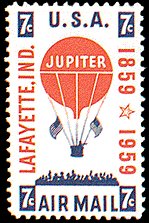

David Hollenbaugh
Collecting balloon stamps and balloon mail is an exciting, interesting, and colorful area of topical specialization for both the beginner and the advanced collector, and is suitable for nearly every pocketbook. A good place to start a balloon stamp collection is with the many 1983 issues commemorating the Montgolfier brothers and the 200th anniversary of manned flight. Over 50 countries issued balloon stamps or souvenir sheets that year. Although the frequency of new balloon issues has since diminished, there is a more historically diverse selection of earlier worldwide issues, many dating from the thirties, which commemorate contemporary scientific or exploratory flights, or other notable ballooning events. They are a bit pricier than the more recent issues. Balloon aerogrammes, though fewer in number than either stamps or covers, are also collectible.
Balloon flown covers are very popular and are becoming more numerous each year. Some covers are prepared for transoceanic and other long distance balloon flights, usually in limited quantities. These are invariably offered at a premium in order to help defray the cost of the flight, but make great additions to any collection.
Souvenir covers issued for a specific ballooning event, such as the annual U.S. National Hot Air Balloon Championships and the Kodak Albuquerque International Balloon Fiesta, are inexpensive, readily available, and come in endless varieties. Look for covers with a ballooning cachet, a special pictorial cancellation, a balloon stamp (the recent 19¢ U.S. definitive issue for example), the name of a participating balloon, and the pilot’s signature. All of these elements on one cover amount to a collecting “grand slam.”
Balloon “monte” materials comprise a specialized field within the ballooning topic. Ballon Montes are pieces of mail flown from Paris by gas balloon between September 1870 and February 1871 during the Franco Prussian War. The name, short for Par Ballon Monte or “by manned balloon,” reflects the notation required on each postal item flown. Balloon montes are relatively expensive and prices can vary according to specific balloon and markings, but having one of these letters, cards, or journals in your collection is like owning a piece of both ballooning and philatelic history.
Visit the concession areas at major ballooning events and ballooning museums to find flown mail. You can visit stamp dealers and read the stamp papers for articles and ads. Or chase a balloon and ask the pilot! To build a collection of balloon stamps, use a world-wide stamp catalogue. For balloon mail a variety of catalogues are used, including the out-of-print Balloon Posts World Catalog 1783-1968 by Boesman and the AAMS publication Balloon Posts of the Siege of Paris 1870-1871 by Chantrier.
One of several balloon stamps issued in the United States.
